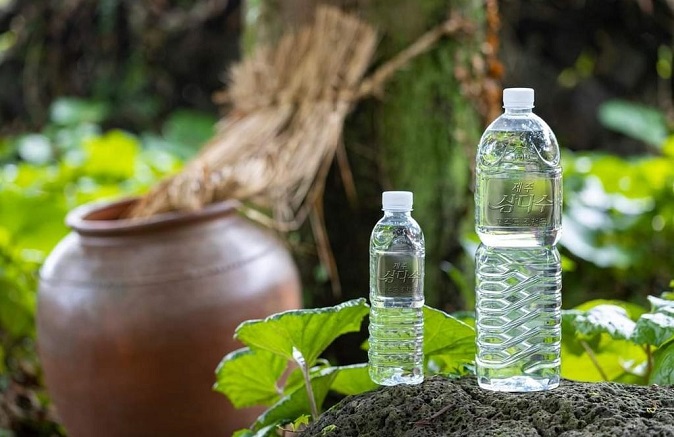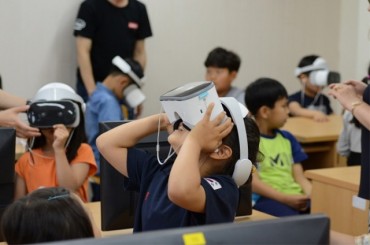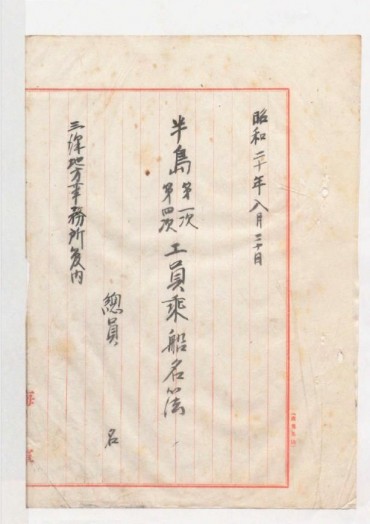SEOUL, June 2 (Korea Bizwire) — Jeju Samdasoo, one of the most popular bottled water brands in South Korea, joyfully announced its 25th anniversary celebration on Wednesday, accompanied by a remarkable achievement of cumulative sales exceeding 3.5 trillion won (US$2.68 billion).
With an unwavering market dominance of 40 percent over the past five years, this iconic brand continues to reign as the undisputed leader in the realm of bottled water within South Korea.
The extraordinary popularity of Samdasoo can be attributed to its association with the pristine image of Jeju Island.
Particularly noteworthy is the fact that Jeju Samdasoo’s water source resides within a verdant forest area adjacent to the renowned Mount Halla National Park.
This locale, celebrated for its unblemished environment devoid of pollution sources, boasts a well-preserved natural primitiveness that further enhances the brand’s allure.
Situated on a volcanic island formed by volcanic activity spanning from approximately 1.9 million years ago to 5,000 years ago, Jeju Samdasoo derives its distinction as volcanic rock water due to its origins within these volcanic rock layers.
This unique characteristic grants it a singular status among other bottled water brands.

Tourists snorkel in waters near a port in the city of Jeju on South Korea’s largest island of the same name on June 7, 2021. (Yonhap)
However, lingering concerns have emerged regarding the potential fluctuations in water quality.
In response to such apprehensions, the Jeju Province Development Co. (JDPC), responsible for the development and management of Jeju Samdasoo, has reassured consumers that since its launch in February 1998, Samdasoo has consistently undergone rigorous water quality testing by reputable entities such as the the U.S. Food and Drug Administration, Japan’s Ministry of Health, Labour and Welfare, and China’s authorized agencies.
These tests have steadfastly affirmed the safety and unwavering quality of Samdasoo.
In particular, the JDPC emphasizes the absence of any detectable radioactive substances in the water, even after conducting 75 tests since the massive earthquake on Japan’s east coast in March 2011.
Such findings reinforce the assurance that Jeju Samdasoo remains exceptionally free from any radioactive contaminants, making it a secure choice for consumers.
Nonetheless, the recent discharge of contaminated water from the crippled Fukushima Daiichi nuclear power plant into the ocean raises valid concerns about the potential radioactive impact on Jeju Island.
This situation poses a severe threat to the island’s fisheries industry, which symbolizes a pristine region within South Korea, now teetering on the precipice of crisis.

This file photo taken on Feb 27, 2020, shows the now-decommissioned Wolsong-1 nuclear reactor in Gyeongju, 370 kilometers southeast of Seoul. (Yonhap)
Experts predict that contaminated water from the Fukushima nuclear plant could potentially reach Jeju’s shores as early as seven months after the catastrophic incident.
Simulations conducted by Tsinghua University in China further fortify these concerns, projecting that the Fukushima contamination may permeate South Korea’s southern coast, including Jeju Island, 260 days following the ocean discharge.
This perilous plume is predicted to engulf the entire nation within 400 days and eventually find its way into the Pacific Ocean within a decade.
Moreover, it is vital to acknowledge that nuclear facilities themselves can contaminate groundwater, as highlighted by the recent discovery of widespread groundwater contamination with the radioactive substance tritium at the Wolsong Nuclear Power Plant site in Gyeongju, North Gyeongsang Province.
The Korea Hydro & Nuclear Power Co. (KHNP), responsible for the investigation, has confirmed that underground pipes and spent nuclear fuel storage tanks represent the primary sources of tritium in the groundwater.
As a result, the KHNP has implemented measures to replace and repair these facilities.
Tritium, a contentious radioactive substance present in abundance in the contaminated water from the Fukushima nuclear disaster, is known to induce internal radiation in humans, potentially leading to genetic mutations.
The release of radioactive material from a nuclear power plant through non-prescribed pathways is strictly prohibited under the Atomic Energy Act.
Experts who have examined the KHNP report underscore the fact that tritium leaks are not solely confined to damaged parts of the facility but may also infiltrate the facility itself.
Unlike gamma nuclides such as cesium and technetium, tritium atoms are remarkably small, enabling it to permeate through iron atoms even within thick steel plates.
Currently, debates persist regarding the extent of the discharge of contaminated water from the Fukushima plant into the ocean.
In a related development, Tokyo Electric Power Co. (TEPCO) has implemented a “wall of ice” strategy to contain the contaminated water within the plant premises, effectively preventing groundwater intrusion that leads to radioactivity when in contact with highly radioactive debris in the reactor basements.
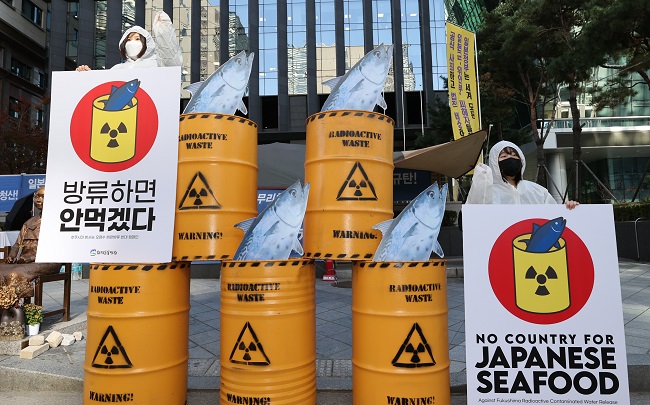
Activists stage a campaign near the Japanese Embassy in Seoul calling for the boycott of Japanese seafood in protest against Tokyo’s plan to discharge into the sea radioactive water from its wrecked Fukushima nuclear power plant, in this photo taken Nov. 9, 2020. (Yonhap)
However, concerning reports from Japanese broadcaster NHK indicate that this wall may have already begun melting, with certain sections experiencing an alarming temperature increase from the intended minus 30 degrees Celsius to 13 degrees Celsius.
These observations cast doubt on the effectiveness of measures aimed at curbing the surge in contaminated water.
While the Japanese government has insisted that the contaminated water stored at the Fukushima plant is safe, doubts persist among critics within Japan.
In August 2018, Japanese media exposed that approximately 70 percent of the water contained in the tanks at the plant exhibited radioactive substances that pose lethal risks to humans, such as cesium, strontium, and iodine, surpassing legal limits.
Notably, strontium-90 levels 20,000 times higher than legal limits were detected in some tanks.
The failure of the highly touted advanced liquid processing system (ALPS), designed to filter out all radionuclides except tritium, was identified as the root cause of this alarming revelation.
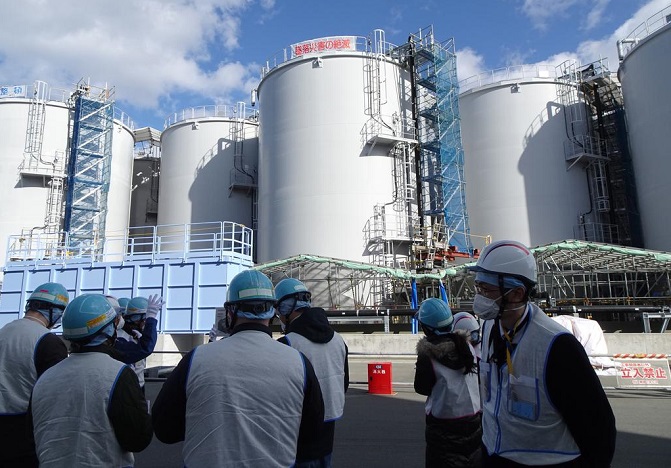
In this file photo, officials at Tokyo Electric Power Co., the operator of the crippled Fukushima nuclear plant, speak to journalists at Fukushima Daiichi Nuclear Power Station on Feb. 2, 2023. (Yonhap)
Previously, TEPCO had claimed that the water purified by ALPS was devoid of any radioactive material, leaving only tritium — an assertion that was ultimately proven false.
TEPCO now contends that secondary purification utilizing ALPS will effectively reduce radioactivity below standard thresholds. Yet, given the substantial level of existing skepticism, blind acceptance of this claim is untenable.
The specter of radioactive contamination looming over the Korean Peninsula is not confined solely to the Fukushima plant’s contaminated water.
Concerns persist regarding the potential radioactive contamination of groundwater in the Mount Paektu region as a consequence of North Korean nuclear tests, which could have cascading effects across the peninsula.
As nuclear testing endures, the subterranean environment becomes increasingly unstable, providing optimal conditions for groundwater contamination.
Worries have been voiced regarding the groundwater’s vulnerability to radioactive materials at North Korea’s Punggye-ri nuclear testing site, as well as the potential radiation exposure endured by individuals residing in nearby areas.
The South Korean government has commenced radiation exposure testing for all North Korean defectors originating from the Punggye-ri site.
A representative from the South Korean unification ministry conveyed in a recent telephone interview with American broadcaster Voice of America (VOA) that testing commenced on Nov. 15 and the results will be disclosed by year-end.
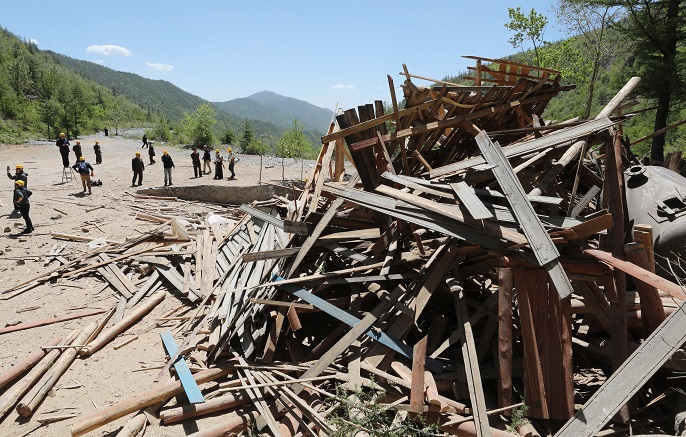
In this press pool file photo, debris is piled up after Tunnel No. 2 of North Korea’s only known nuclear test site Punggye-ri is blown up on May 24, 2018. (Yonhap)
The historical context of the Soviet Union provides a poignant example of how radiation spread to apartments located hundreds or even thousands of kilometers away from nuclear power plants.
These plants are typically constructed near rivers, streams, and seashores, which inadvertently generate contaminated water.
When this tainted water flows downstream, it invariably contaminates soil and water across vast expanses, extending hundreds of kilometers and beyond.
It is imperative to recognize that the discharge of nuclear contaminated water into the ocean transcends the boundaries of a purely South Korean quandary.
Indeed, attempting to resolve this predicament solely within the Japan-South Korea bilateral framework would be inadequate, as the highly toxic water’s proliferation in the world’s oceans would constitute an absurdity.
Consequently, the discharge of contaminated water from nuclear power plants represents a grave issue that endangers the entire world, posing irreversible risks that demand urgent attention and resolution.
Jerry M. Kim (jerry_kim@koreabizwire.com)


